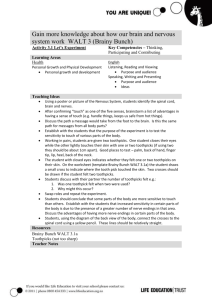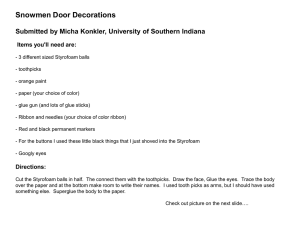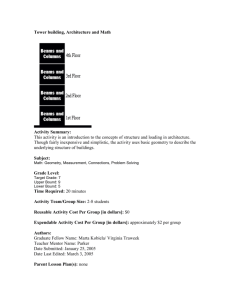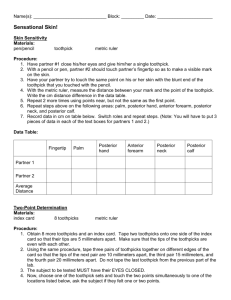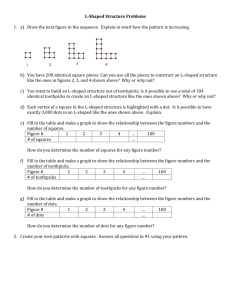Creative Concepts
advertisement
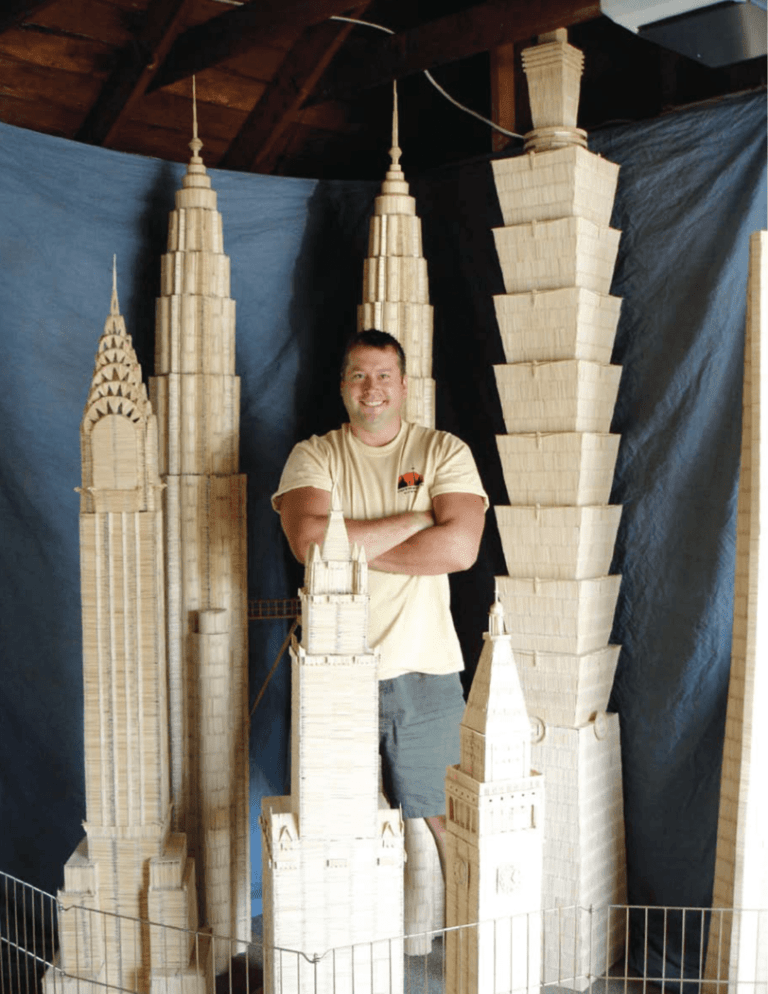
Creative Concepts 48 february 2010 Architecture Like You've Never Seen Before Above: Grand Mosque- Mecca, Saudi Arabia and surrounding buildings for Toothpick City II; opposite: (From left to right) Chrysler, Petronas, Woolworth, MetLife, Tai Pei 101. Meet the toothpick genius W ho would have ever thought toothpicks could turn into structures of wonder? We sure didn’t… until we met Stan Munro, the man behind the remarkable Toothpick City. In our exclusive interview with Stan, we meet a man with incredible talent and a great sense of humor. Replicating iconic temples and towers from around the world, Stan continues to amaze us, gluing together what we only thought could pick between our teeth into astonishing works of art. Meet Stan Munro I grew up on a farm in upstate New York. We had pigs, chickens and a couple of cows. My brother, sister and I all grew up with chores to do around the house but we always found ways to amuse ourselves (other than television). We attended a small Methodist church at the edge of the county line. It was a simple way of life. But that all changed when I went to college in New York City where I studied advertising and journalism. It was a culture shock to say the least, but I learned a lot. After college, I travelled the country for about a year. I lived in Atlanta and Seattle, but finally settled down in Syracuse, NY, with my beautiful wife and four unruly but lovable dogs. And I glue toothpicks together. Life is good. The famous question- How did you get started making art out of toothpicks? The famous answer- Girls. Let me explain: In 5th grade art class, our teacher asked us to make a tower out of toothpicks that was at least six inches tall and could hold the weight of an egg... mine held my desk... a cute girl smiled at me. That was it. I was hooked. Over the years, I made buildings out of toothpicks (mostly Asianstyle pagodas) and gave them away to girlfriends. Mostly, these toothpicks were returned as a pile of rubble. The hobby stayed with me into my adult years--always a nice release from the day-to-day monotony. Then, after a rather lengthy 3-month unemployment spell, I thought of making a whole city out of toothpicks. I kept at it like it was the most important job interview of my life--sometimes 18 hours a day. It was accepted into the New York State Fair, and it was a huge hit. I still hadn’t made any money at it, but my wife believed in me, and I kept at it, until one day a museum in Spain offered us more money than I had ever made at any other job... and just like that: it became a job. Today, I not only glue toothpicks for a living, but I try to make each building better and more detailed than february 2010 49 Creative Concepts the one before. Because now I glue toothpicks for just one girl--my wife. Before this became your full-time career, did you work elsewhere? I’ve had more jobs than I’ve had birthdays. Most recently I was a TV presenter at a couple local TV stations. I was the wacky morning man who tried to take people’s minds off the real world if only for a moment. It was a fun job, but more exhausting than anyone ever knew. Before that, I traveled the country writing stories for True Detective Magazine. It was exciting, but a bit morbid, and eventually too disturbing to continue. I’ve had a host of other jobs at hospitals, shopping malls, restaurants and the dreaded office cubicles... But no matter how stressful, boring or dead-end the job felt--I could always sit back and make something out of toothpicks. That made me feel better. But never... never did I think I could make a career out of gluing toothpicks. When did you first get recognized? When you e-mailed me a couple months ago. No, really. Just after the British Wire Service picked up the story, I got flooded with e-mails from around the globe. Yours was one of them. It’s been a lot of fun. More than 35 countries have done stories on it so far. I’m still waiting for my own country to pick up the story, but oh well... How do you execute your work? If you mean the toothpick engineering part of my work, that is simple. I line up toothpicks in a long strip, put masking tape on the back, and glue a line of toothpicks on either side of the tape. When the glue is dry, I take the tape off. That’s how 80 percent of my toothpicks start out. With the strips, I make panels, and from the panels, I cut out what I need. The rest is just fiddling around until I find something that works. Spheres are sculpted around styrofoam balls. When the glue dries, I take it off the ball (or whatever mold I choose). In the end, there’s nothing but toothpicks and glue. If you mean the planning part of my work, that’s a little more involved. There’s a large map of the world that sits in front of me in my basement workshop. If I find an interesting building in a country that’s not represented in my exhibit, or a specific faith I have yet to include, or it’s simply a style of architecture that’s unique and different... then I start working. First, I need numbers, a reliable set of measurements--at least the height and width of a building--two sources if I can. Then I start finding photos off the Internet. Blueprints. Satellite photos. Resource books. Using simple algebra, I can find out how big a building will be at my 1:164 scale. The Burj Khalifa is 818 meters, so I knew mine had to be about 5 meters tall.... what? Really? 5 METERS ... OUT OF TOOTHPICKS?!?! OK, the next stage can sometimes turn into panic or fear. Sometimes a building “stays” in the planning phase until I can figure out what needs to be done. I usually go onto something easier at that point... 50 february 2010 Creative Concepts Right: Tower Bridge- London, England; below: Grand Mosque- Mecca, Saudi Arabia; opposite above: Wat Arun- Bangkok, Thailand; below: Stan and Tower Bridge. How long does it take to finish one major temple or tower (on average)? On average, a tower will take about a week, but a major temple will take at least a month. They all vary in length, and I’m usually working on at least 2 buildings at the same time. I don’t know why, but it’s nice to work on a temple and a tower simultaneously. I like to do the detail work on a temple, but the faster-paced construction of a tower makes me feel like I’m actually getting something done. I know... I’m weird. Where are your finished pieces kept? Do you sell them? As soon as I’m finished with a piece, it goes into the exhibit, which is currently at the Museum of Science & Technology in Syracuse, NY. All the temples are around the outside of the 24 x 28 foot oval exhibit, and the towers dot the inside, increasing in size and culminating with the 5-meter-tall Burj Khalifa in the center. I don’t normally sell individual pieces, but I’m considering a “Signature Series” of towers that I built 6 years ago that went into my first exhibit: Toothpick City I: History of Skyscrapers. Then, I would sell individual classic buildings such as the Empire State Building and Eiffel Tower, and the new classics such as Petronas Towers and Al Faisaliah Center. If that happens, I will let people know through my website. “ If I find an interesting building in a country that’s not represented in my exhibit, or a specific faith I have yet to include, or it’s simply a style of architecture that’s unique and different... then I start working. ” february 2010 51 Creative Concepts How do you keep such large models in tact? My toothpick models aren’t exactly all-weather pieces. They definitely need to be in a climatecontrolled environment, but they are quite sturdy. The insides are braced with many more toothpicks. The Burj Khalifa, for example, has almost a halfmillion toothpicks in it, but I don’t coat or varnish the outside of the toothpicks for one very good reason: I want them to age. It may take a good 20 years or so, but when the toothpicks start to take on their own individual darker hues... it’s beautiful. Yes, I know I’m a geek, but the toothpicks will eventually look... like toothpicks. Right now everything is still white-washed and new looking, but trust me... I hope I’m still alive to see it. Your buildings are precise to the detail. Where do you get the dimensions and angles of all these structures? I try not to look at the big picture. Well, I look at it, plan it out, but then I have to forget about it because it can be quite intimidating. I say to myself: Today, all I have to do is figure out the floor plan. Why bother scaling out a satellite photo when I can just enlarge the photo to the actual size I want it to be and then “trace” the building on top of the photo. I know it’s not very artistic, but I’d rather the building be as accurate as possible. I try to never go off of one set of numbers for a building (Wikipedia is nice, but not always accurate). Two independent sources are better than one. The inner walls are the next to go up. Each building has what I call a “skeleton,” an inner part that has to be built before anything else can be done. One step at a time. Segments of the building can be built separately, and in assemblyline fashion. The details come closer to the end. That’s usually the fun part. And while I appreciate you saying they’re detailed, I know there’s always more that can be done. Somewhere along the line I have to stop myself or I’ll go insane (if I haven’t already). I just have to remember that I want to give people a good idea of what the real building looks like. If you like my version... you should see the real thing. There’s always some sort of challenge in every job, what would you say is the most challenging about yours? I don’t leave the house. I don’t talk to people. My social skills have atrophied to the point where I would probably act like a caveman if forced to go to a party. People who see my work automatically assume that I have no life. Those people would be correct. So the most challenging part of my job is just being alone with my wife and four dogs. I’ve gotten quite comfortable. But one of the GOOD parts of my job is that I really don’t have to leave the house anymore... or go to parties and talk to people... ;) What inspired you to replicate buildings here in the Middle East? The amazing buildings in the Middle East inspired me. Just as America saw an architectural boom in the 1930’s, the Middle East is seeing that 52 february 2010 Creative Concepts Left: Bahrain World Trade Center; below: Big Ben & Brooklyn Bridge- Toothpick City I; opposite above: Various towers (left to right): Tokyo Tower, Vegas Stratosphere, Riga Tower, Tashkent, Shanghai, Burj Dubai, Aspire, Ostankino, Bahrain, Sydney, King Hassan II Minaret; below: Stan finishing up Angkor Wat, Cambodia. now. It’s amazing to follow the progress, and the best time for someone like me. I can’t wait to see what comes out of the Middle East next. The Grand Mosque in Mecca that you built is out of this world! How did you manage this one and how long did it take to finish? First-of-all, thank you. The Grand Mosque is definitely a favorite of people passing through the museum. It took more than three months to build it and even longer to plan “how” to build it. This was one building (like the Burj Khalifa) that I sat in awe at the size and scope of it, and eventually put it aside until I could figure it out. I ended up building it in five main segments that had to be built alongside each other to give the illusion that it is one piece. It was incredibly difficult, but I believe it was worth the effort. Bahrain, as well as the region, has many largescale developments up and coming, do you plan to add any to your collection? Of course. I will continue to add new and innovative buildings to my exhibit as long as it is in my possession, and I know there are many planned in your region. I try not to get too excited about buildings in these difficult times (especially when I heard the Nakheel Tower was cancelled), but I am always taking building suggestions at stan@toothpickcity.com “ My own imaginary Toothpick City III is being influenced greatly by the Bahrain World Trade Center. That’s all I can say right now, but it would be... (for lack of a better word)... “extreme”. ” What are your current projects? I am still working on Toothpick City II, and I hope to finish it this year. Right now I am working on the Ryungyong Hotel in North Korea and the Djenne Mosque in Mali, Africa. And I’m always anxious for that next e-mail that can point me in a new direction. Have you ever thought of designing your own “Imaginary Toothpick City”? Yes, I have. As a matter-of-fact, the current idea for my own imaginary Toothpick City III is being influenced greatly by the Bahrain World Trade Center. That’s all I can say right now, but it would be... (for lack of a better word)... “extreme”. What future plans do you have with your work? I honestly don’t know what the future holds for Toothpick City II: Temples & Towers. A couple museums have expressed interest in it, but I’m really not ready to sell until at least April of this year. Maybe it will end up in the Middle East. My first city ended up in a museum on an island off the coast of Spain that I had never heard of before. Who knows where this one will go? It’s kind of exciting. (OK, a little scary too). AH For more information: www.toothpickcity.com february 2010 53
